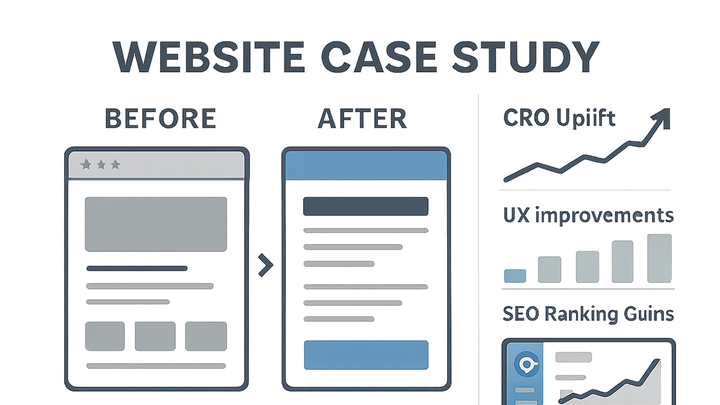Published on 2025-06-29T20:41:01Z
What is a Case Study? Examples for CRO, UX & SEO
In the world of website optimization—where Conversion Rate Optimization (CRO), User Experience (UX), and Search Engine Optimization (SEO) intersect—a case study is a structured narrative that documents how targeted changes impact real-world metrics. It outlines the initial challenges, the hypotheses formed, the methodology for testing (often leveraging tools like Prevue.me for actionable critiques on lead generation, performance, accessibility, and user flows), and the quantitative results achieved. By presenting before-and-after data points—such as conversion lift, improved page load times, or keyword ranking gains—a case study transforms raw analytics into compelling stories. These stories not only guide future optimization efforts but also serve as powerful marketing collateral to demonstrate expertise and build client trust. Well-crafted case studies connect strategy, execution, and results in a clear, replicable format that stakeholders across design, development, and executive teams can appreciate.
Case study
A case study details the problem, approach, and results of CRO, UX, and SEO optimizations on a website.
Purpose and Benefits
This section explores the main objectives and advantages of using case studies in website optimization, including demonstrating ROI, sharing best practices, and building credibility.
-
Demonstrate real-world impact
Case studies showcase real-world impact by highlighting measurable improvements in conversion rates, traffic, and user engagement.
- Quantitative metrics:
Include before-and-after data such as conversion rate, bounce rate, and page load times.
- Qualitative feedback:
Incorporate user testimonials or survey results to enrich numerical data.
- Quantitative metrics:
-
Share actionable insights
They distill complex analyses into clear recommendations that teams can apply immediately.
- Tactical recommendations:
Provide clear steps for replicating successful strategies.
- Mistakes to avoid:
Highlight pitfalls encountered during the process.
- Tactical recommendations:
-
Enhance credibility
Publishing data-backed success stories builds trust with clients, stakeholders, and prospects.
- Cross-functional approval:
Show endorsements from design, development, and executive stakeholders.
- Industry benchmarks:
Compare results against industry averages or competitors.
- Cross-functional approval:
Structure of a Case Study
An effective case study follows a clear framework to guide readers through objectives, methodology, results, and takeaways.
-
Executive summary
Summarize key findings, metrics, and outcomes in a concise overview.
- High-level highlights:
Summarize key findings and metrics in fewer than three sentences.
- Outcome snapshot:
Highlight the most significant improvement, such as a 25% conversion lift.
- High-level highlights:
-
Challenge & goals
Define the core problem and set measurable objectives that align with business KPIs.
- Define the problem:
Clearly state the user experience or SEO issues addressed.
- Set measurable objectives:
Align goals with specific KPIs like page load time or organic traffic.
- Define the problem:
-
Methodology & tools
Describe the research techniques, tests, and tools used to gather insights and validate hypotheses.
- Research techniques:
Detail usability tests, heatmaps, or SEO audits performed.
- Tools utilized:
Mention prevue.me for actionable critiques, Google Analytics for traffic analysis, and other relevant platforms.
- Research techniques:
-
Results & analysis
Present the data, interpret the findings, and assess their significance.
- Data visualization:
Use charts and graphs to make results easily digestible.
- Statistical significance:
Explain whether improvements are statistically robust and not due to random variation.
- Data visualization:
Using Prevue.me for Website Critiques
prevue.me is a SaaS platform that provides actionable critiques across CRO, lead generation, SEO, UX, and accessibility, making it an invaluable tool for gathering data and insights for your case studies.
-
Automated site audits
Run comprehensive scans to identify performance issues, technical SEO gaps, and UX bottlenecks.
- Performance metrics:
Monitor load times, mobile responsiveness, and Core Web Vitals.
- Conversion bottlenecks:
Identify pages or elements hindering lead generation and clarity.
- Performance metrics:
-
Expert ux feedback
Leverage professional critiques to uncover usability issues and streamline user journeys.
- Heuristic analysis:
Review usability based on established UX principles.
- User flow recommendations:
Enhance navigation and call-to-action placement for smoother experiences.
- Heuristic analysis:
-
Seo & accessibility reports
Receive tailored reports that combine SEO best practices with accessibility standards.
- On-page seo:
Optimize keywords, meta tags, and content structure for better rankings.
- Accessibility compliance:
Check WCAG guidelines adherence, alt text usage, and keyboard navigation support.
- On-page seo:
Best Practices for CRO/UX/SEO Case Studies
Following best practices ensures your case studies are clear, impactful, and replicable.
-
Maintain data integrity
Ensure all metrics are accurate, well-sourced, and transparently reported.
- Source verification:
Double-check data against original analytics tools.
- Transparent methodology:
Disclose sample sizes, testing durations, and any limitations.
- Source verification:
-
Use visual aids
Complement text with visuals to communicate insights effectively.
- Charts & graphs:
Simplify complex data for quick comprehension.
- Annotated screenshots:
Highlight key UX improvements directly on the interface.
- Charts & graphs:
-
Tell a compelling story
Craft a narrative that connects challenges, actions, and outcomes.
- Narrative flow:
Lead the reader clearly from problem to solution to results.
- Human element:
Incorporate user quotes or team reflections to add authenticity.
- Narrative flow:
-
Keep it actionable
End with clear recommendations that can be implemented immediately.
- Clear recommendations:
Provide step-by-step guidance for replicating success.
- Scalability notes:
Explain how strategies can be adapted to other contexts.
- Clear recommendations:
